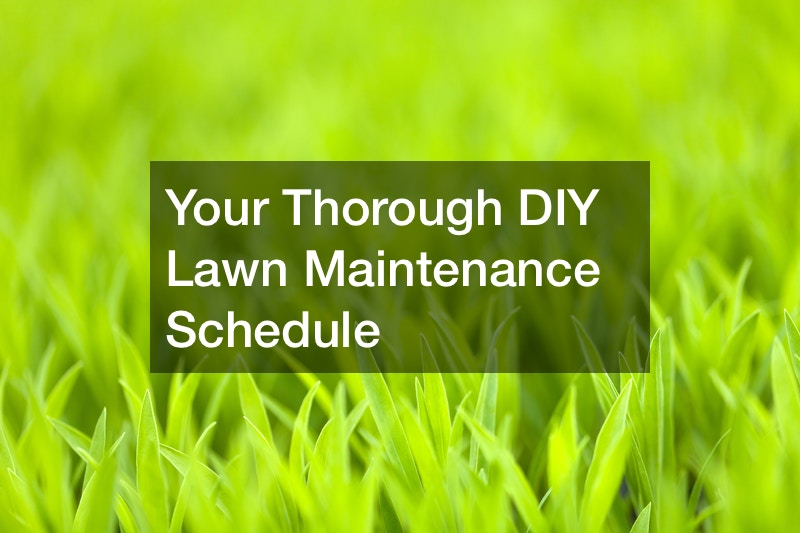
Maintenance of a lawn is essential to get the best out of your plants and trees. The effort you put in will pay off because a beautiful garden can be yours. If you have numerous plants, shrubs, and so on, all the better because it can give a wonderful touch to your surroundings. You may want to know how to maintain your lawn, so here are some useful ideas;
Trim Trees and Shrubs

Leafy plants such as trees and shrubs provide shade and privacy and add an aesthetically pleasing look to your lawn. However, leafy plants can accumulate plenty of leaves throughout the year. If you fail to remove those leaves regularly or find cheap tree removal alternatives to do away with unwanted trees, it can cause blockage in drainage outlets and affect plant health. The frequency of cutting your leafy plants depends on the type of plant, the size of the leaves, and other growth factors. A typical DIY lawn maintenance schedule indicates that the smaller the leaf blades are, the more frequently they should be trimmed. For instance, small-leaved trees such as the Japanese maple need to be pruned every year in early spring before new growth begins.
On the other hand, plants with larger leaves like weeping willow require trimming only every three to four years. Tree and shrub pruning is ideal during early spring or winter to avoid disturbing their dormancy period. Any competent local arborist would advise you to trim your ground cover at least twice a year to avoid overgrowth and maintain the lawn’s aesthetic appeal. For example, hydrangeas should be trimmed in late spring before flowering begins. In most cases, trees and shrubs need to be pruned for their health. If you notice any damages to the bark or branches of your plants, it’s better to seek the advice of a tree company that offers tree trimming service.
Lawn Mowing

Lawn mowing is one of the most important residential lawn care practices that should be included in a DIY lawn maintenance schedule. If your yard grass grows too long, the lawn will look shaggy and could begin to harbor diseases or other problems that can kill your lawn. Different types of grass have different needs for being cut; however, a rule of thumb in most areas is to mow when the grass reaches a height of 3 inches. Depending on how often it rains, this could be 2 to 3 times per week for many yards. Owners will need to develop their schedule based on conditions such as rainfall and sun exposure.
Once or twice per week seems like normal intervals for lawns in many areas. However, mowing more frequently results in damaged grass and increases the chances of developing diseases. Same thing if you cut out less; you end up with an overgrown yard that is difficult to care for, and the lawn may be at risk for disease or pest problems like grubs. As grass blades grow, they push toward the sun and form a rounded tip. This is why it’s best to mow during the early morning or late evening when grass blades are long and less prone to breaking, as opposed to midday when the blades are weaker.
Weed Control
In general, most broadleaf weeds need to be controlled every two weeks between early spring and mid-fall. Weeds that grow and produce seeds rapidly, such as knotweed, dandelion, speedwell, and chickweed, may need to be controlled every 1 to 2 weeks. Spot treatment or blanket spraying are equally critical and should be incorporated into a DIY lawn maintenance schedule. With spot treatments, the concentration of chemicals should be three times stronger than with a broadcast spray, but the coverage area may be less uniform. Broadleaf herbicides are environment-friendly and cause no harm to humans, animals, or water supplies when used according to directions on the label.
Weed control may also be accomplished by nonchemical means, such as the use of mulches. Any forestry mulching company will allow you to apply organic mulch after the newly seeded lawn has begun actively growing; it is recommended that you get it from a shop that deals in landscape supplies and other relevant products. Synthetic mulches can prevent weed growth for many years. A plastic covering is effective, but after several years the sun’s heat and gases may cause damage to surrounding plants. Newspaper, sawdust, and wood chips are all effective mulches.
Watering

Watering depends on the conditions around your lawn and not just the type of grass you have. Seasonal conditions have the most influence on how frequently you should water your lawn. In general, turf grown in shaded areas or under cool conditions requires less frequent watering than turf grown in hot, sunny locations. Pay attention to your grass when watering your lawn. If it appears that the soil around the base of the grass is drying out when you come in after breakfast and in the evening, then more frequent watering might need to be prioritized on your DIY lawn maintenance schedule. But if it still feels damp in the morning and the early evening, less water may be needed.
Calculator tools exist to help you determine the frequency and volume of watering needed based on your location and other relevant conditions. Be sure to use a good irrigation sprinkler system. Poor watering is wasteful and inefficient, and it wastes water as well as money. Overhead watering is ineffective and can lead to problems such as root diseases and fungal growth on the grass. Good watering means applying water directly to the soil surface, not just wetting the grass. Use a screwdriver as a quick tool to tell whether water is reaching the lawn’s root zone.
Roller Grading
As the grass grows, it develops thatch, which is a layer of undecomposed stems and roots. This forms on the soil surface under turfgrass plants due to the shedding of above-ground plant parts or root tissue. As this layer becomes thicker, it suffocates the lawn because water cannot penetrate through the thatch. Grasses that are growing under stress or in compacted soils will shed thatch quickly. Roller grading needs to be done because it helps separate the soil particles and remove the buildup of thatch underneath. If your lawn can’t breathe, it can cause big problems with water drainage. As you work on designing your DIY lawn maintenance schedule, remember to include roller grading at least once a year. Grasses such as Bermuda and zoysia develop the most thatch and require more frequent roller grading than cool-season turfgrasses. This is because they shed roots faster under stress or when grown in compacted soils. Roller grading also prevents soil compaction in high traffic areas where grass blades are flattened out across the soil’s surface. Roller grading is very important to maintain a beautiful and healthy lawn.
Topdressing
Topdressing your lawn should be prioritized in your DIY lawn maintenance schedule. Topdressing is used mostly with creeping bentgrass, but it can be done on any turf. A top-dressed lawn will have better health with improved traffic tolerance. It adds organic matter to the soil, which helps increase water retention, aeration, root depth, and disease mitigation. Topdressing should be done every 1-2 years, but if it is done more frequently, make sure to use slow-release lawn fertilizer. The first step to topdressing a lawn is to mow the grass down as low as possible. This ensures that the layer of new topsoil will be thin and even on your lawn. Then, use a shovel or garden rake to spread out a thin layer of topsoil throughout your entire lawn. Make sure it is only a half-inch deep. If it is deeper than half an inch, you will have to use a top dresser or drag mat to pull up the soil. You can also spread out organic fertilizer throughout your lawn before you start to mix it in with the topsoil and grass.
Seeding
A lawn seeded with the correct grass species, grown under proper conditions, and established at the correct time of year can provide years of healthy, attractive turf. The best time to seed your lawn depends on several factors, including what type of grass you want to grow. Warm-season grasses such as Bermuda grass, Bahia grass, and Zoysiagrass used to be seeded in early spring or late summer to provide a full lawn by late summer or early fall. However, recent research has demonstrated that seeding at other times of the year may also effectively establish desirable grasses, especially warm-season grasses.
The growing season in your geographic region also determines the best time to seed. Although seeding at any time when soil conditions are favorable is possible, you can expect the best results when grass seed germinates and is well established before the onset of harsh autumn weather. Seed loss during establishment reduces the seed population and leaves open spaces in the lawn. To ensure that you have a practical DIY lawn maintenance schedule, you should seed as close to the time of expected snowmelt as possible.
Fertilization
One of the most important things you can do for your lawn is fertilize it. Lawn fertilization plays a central role in your DIY lawn maintenance schedule. It deodorizes, and boosts iron and nitrogen in the soil, feeding grass and microorganisms. But how often should this be done? The answer to this question is simple: you should fertilize as often as possible. Your lawn will benefit greatly from this process, and the result is a greener, healthier lawn. Clippings can be left on the grass because they eventually decompose and provide your yard with all of the necessary elements such as nitrogen and phosphorus. However, you should be careful because if you fertilize too often, the lawn will have much excess grass, which can become an obstacle and is harder to fertilize. Hence, the best thing to do is fertilize once a week. If you don’t know how to do it yourself, hire a gardener or landscaper to help you with this process. Don’t worry about over-fertilizing your lawn. If your grass turns yellow, you will know that there is too much fertilizer, and it can’t handle the excess nutrients, so do not continue to fertilize beyond this point.
Lawn Aeration

Lawn aeration is a practice where holes are created in the soil of lawn or meadows. The process has been done for the past decades, and the main purpose is to improve your DIY lawn maintenance schedule. Aerating your lawn can be done regularly or according to a schedule depending on ground conditions. However, it is good to aerate your lawn once a year, and it should be done during the end of the fall season. This is when grass growth slows down, and there is no danger of scalping or tearing your grassroots. The planting season is also approaching, and your lawn would benefit from well-aerated soil. Not only does lawn aeration improve the health of grass, but it also enhances its drainage capacity.
The process loosens the compacted soil, allowing for better water penetration by rain or irrigation systems. With correctly aerated soil, you won’t have to water your lawn as often. This is because when soil becomes compacted, it blocks the passage of water, and this causes a build-up in the soil. So you have to spend more time watering your lawn. Lawn aeration is an important practice, and it pays to invest in a core lawn aerator. The whole process can be done by hand or with the aid of an aerator that has retractable tines.
Insect Control
Insects leave behind visible damage, such as chewed leaves or open tunnels in the grass. Without control of the insect population, you could end up with large patches of dead grass. Insect damage does not usually kill plants but can affect their health and beauty by causing yellowing, stunted growth, and patchy lawns that do not fill in as dense as before. Insect damage may be a sign of larger problems on the lawn that could interfere with your entire landscaping outlook. It would help if you also stuck to your DIY lawn maintenance schedule and watched out for discolored grass or leaves with a scorched appearance. It is important to know what insects are causing damage and the best insecticide to use to prevent insect damage.
The timing of insecticide applications varies with each group of insects. It can be difficult to control some insects unless you practice good lawn care, including proper watering, mowing, fertilization, aeration, and thatch removal. The insecticide should be applied according to the manufacturer’s instructions for the best results. Some insects are more difficult to control than others because of their life cycle. For example, grubs are in the soil all summer, and adults may stay on the grass for a few days to lay eggs after they emerge from around your home. Once you have identified what is causing damage to your lawn, it will be easier to prevent future insect damage.
As a homeowner, you may take pride in the home’s appearance and landscape. But for many homeowners, taking proper care of their yard is a chore that they often neglect––in favor of other household tasks or simply because it seems less important than other details. While taking care of your lawn may not be as critical as an essential plumbing issue, there are several other reasons why you should be actively involved in the care of your lawn. Not only does having a well-groomed yard look great, but it also provides important benefits to your home and you as its owner.




